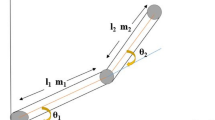Abstract
This paper mainly focuses on designing a sliding mode boundary controller for a single flexible-link manipulator based on adaptive radial basis function (RBF) neural network. The flexible manipulator in this paper is considered to be an Euler-Bernoulli beam. We first obtain a partial differential equation (PDE) model of single-link flexible manipulator by using Hamiltons approach. To improve the control robustness, the system uncertainties including modeling uncertainties and external disturbances are compensated by an adaptive neural approximator. Then, a sliding mode control method is designed to drive the joint to a desired position and rapidly suppress vibration on the beam. The stability of the closed-loop system is validated by using Lyapunov’s method based on infinite dimensional model, avoiding problems such as control spillovers caused by traditional finite dimensional truncated models. This novel controller only requires measuring the boundary information, which facilitates implementation in engineering practice. Favorable performance of the closed-loop system is demonstrated by numerical simulations.
Similar content being viewed by others
References
T. Sangpet, S. Kuntanapreeda, R. Schmidt. Hysteretic nonlinearity observer design based on Kalman filter for piezoactuated flexible beams with control applications. International Journal of Automation and Computing, vol. 11, no. 6, pp. 627–634, 2014. DOI: 10.1007/s11633-014-0817-2.
L. Zhang, S. Liu. Iterative learning control for flexible manipulator using Fourier basis function. International Journal of Automation and Computing, vol. 12, no. 6, pp. 639–647, 2015. DOI: 10.1007/s11633-015-0932-8.
Z. H. Luo. Direct strain feedback control of flexible robot arms: New theoretical and experimental results. IEEE Transactions on Automatic Control, vol. 38, no. 11, pp. 1610–1622, 1993. DOI: 10.1109/9.262031.
A.A. Paranjape, J. Y. Guan, S. J. Chung, M. Krstic. PDE boundary control for flexible articulated wings on a robotic aircraft. IEEE Transactions on Robotics, vol. 29, no. 3, pp. 625–640, 2013. DOI: 10.1109/TRO.2013.2240711.
W. He, T. T. Meng, D. Q. Huang, X. F. Li. Adaptive boundary iterative learning control for an Euler-Bernoulli beam system with input constraint. IEEE Transactions on Neural Networks and Learning Systems, to be published. DOI: 10.1109/TNNLS.2017.2673865.
H. J. Yang, J. K. Liu. Distributed piezoelectric vibration control for a flexible-link manipulator based on an observer in the form of partial differential equations. Journal of Sound and Vibration, vol. 363, pp. 77–96, 2016. DOI: 10.1016/j.jsv.2015.11.001.
Z. J. Liu, J. K. Liu, W. He. Modeling and vibration control of a flexible aerial refueling hose with variable lengths and input constraint. Automatica, vol. 77, pp. 302–310, 2017. DOI: 10.1016/j.automatica.2016.11.002.
Z. J. Zhao, Y. Liu, W. He, F. Luo. Adaptive boundary control of an axially moving belt system with high acceleration/ deceleration. IET Control Theory & Applications, vol. 10, no. 11, pp. 1299–1306, 2016. DOI: 10.1049/ietcta. 2015.0753.
W. He, S. Zhang. Control design for nonlinear flexible wings of a robotic aircraft. IEEE Transactions on Control Systems Technology, vol. 25, no. 1, pp. 351–357, 2017. DOI: 10.1109/TCST.2016.2536708.
L. J. Zhang, J. K. Liu. Adaptive boundary control for flexible two-link manipulator based on partial differential equation dynamic model. IET Control Theory & Applications, vol. 7, no. 1, pp. 43–51, 2013. DOI: 10.1049/ietcta. 2011.0593.
B. Z. Guo, F. F. Jin. The active disturbance rejection and sliding mode control approach to the stabilization of the Euler-Bernoulli beam equation with boundary input disturbance. Automatica, vol. 49, no. 9, pp. 2911–2918, 2013. DOI: 10.1016/j.automatica.2013.06.018.
T. Endo, F. Matsuno, H. Kawasaki. Simple boundary cooperative control of two one-link flexible arms for grasping. IEEE Transactions on Automatic Control, vol. 54, no. 10, pp. 2470–2476, 2009. DOI: 10.1109/TAC.2009.2029401.
Z. C. Qiu, J. D. Han, J. G. Liu. Experiments on fuzzy sliding mode variable structure control for vibration suppression of a rotating flexible beam. Journal of Vibration and Control, vol. 21, no. 2, pp. 343–358, 2015. DOI: 10.1177/1077546313487760.
F. Duarte, F. Ullah, C. Bohn. Modeling and dual loop sliding mode control of a two flexible-link robot to reduce the transient response. In Proceedings of the 24th Mediterranean Conference on Control and Automation, IEEE, Athens, Greece, pp. 280–284, 2016. DOI: 10.1109/MED.2016.7536066.
A. Mujumdar, S. Kurode, B. Tamhane. Fractional order sliding mode control for single link flexible manipulator. In Proceedings of IEEE International Conference on Control Applications, IEEE, Hyderabad, India, pp. 288–293, 2013. DOI: 10.1109/CCA.2013.6662773.
S. Kurode, P. Dixit. Output feedback control of flexible link manipulator using sliding modes. In Proceedings of the 7th International Conference on Electrical & Computer Engineering, IEEE, Dhaka, Bangladesh, pp. 949–952, 2012. DOI: 10.1109/ICECE.2012.6471708.
G. Mamani, J. Becedas, V. Feliu. Sliding mode tracking control of a very lightweight single-link flexible robot robust to payload changes and motor friction. Journal of Vibration and Control, vol. 18, no. 8, pp. 1141–1155, 2012. DOI: 10.1177/1077546311416269.
P. E. Kuo, A. Hosein, M. S. Farmanborda. Nonlinear output feedback control of a flexible link using adaptive neural network: Controller design. Journal of Vibration and Control, vol. 19, no. 11, pp. 1690–1708, 2013. DOI: 10.1177/1077546312445497.
A. Farmanbordar, S. M. Hoseini. Neural network adaptive output feedback control of flexible link manipulators. Journal of Dynamic Systems, Measurement, and Control, vol. 135, no. 2, Article number 021009, 2013. DOI: 10.1115/1.4007701.
S. S. Ge, C. C. Hang, T. H. Lee, T. Zhang. Stable Adaptive Neural Network Control, Boston, MA, USA: Springer, 2013. DOI: 10.1007/978-1-4757-6577-9.
T. R. Sun, H. L. Pei, Y. P. Pan, H. B. Zhou, C. H. Zhang. Neural network-based sliding mode adaptive control for robot manipulators. Neurocomputing, vol. 74, no. 14–15, pp. 2377–2384, 2011. DOI: 10.1016/j.neucom.2011.03.015.
T. R. Sun, Y. P. Pan. Adaptive control for nonaffine nonlinear systems using reliable neural network approximation. IEEE Access, vol. 5, pp. 23657–23662, 2017. DOI: 10.1109/ACCESS.2017.2763628.
T. R. Sun, H. L. Pei, Y. P. Pan, C. H. Zhang. Robust adaptive neural network control for environmental boundary tracking by mobile robots. International Journal of Robust and Nonlinear Control, vol. 23, no. 2, pp. 123–136, 2013. DOI: 10.1002/rnc.1816.
W. He, Y. H. Chen, Z. Yin. Adaptive neural network control of an uncertain robot with full-state constraints. IEEE Transactions on Cybernetics, vol. 46, no. 3, pp. 620–629, 2016. DOI: 10.1109/TCYB.2015.2411285.
W. He, Y. T. Dong, C. Y. Sun. Adaptive neural impedance control of a robotic manipulator with input saturation. IEEE Transactions on Systems, Man, and Cybernetics: Systems, vol. 46, no. 3, pp. 334–344, 2016. DOI: 10.1109/TSMC.2015.2429555.
S. S. Ge, T. H. Lee, G. Zhu. Improving regulation of a single-link flexible manipulator with strain feedback. IEEE Transactions on Robotics and Automation, vol. 14, no. 1, pp. 179–185, 1998. DOI: 10.1109/70.660869.
H. H. Lee, J. Prevost. A coupled sliding-surface approach for the trajectory control of a flexible-link robot based on a distributed dynamic model. International Journal of Control, vol. 78, no. 9, pp. 629–637, 2005. DOI: 10.1080/00207170500101664.
L. J. Zhang, J. K. Liu. Nonlinear PDE observer design for a flexible two-link manipulator. In Proceedings of American Control Conference, IEEE, Montreal, Canada, pp. 5336–5341, 2012. DOI: 10.1109/ACC.2012.6314625.
L. Zhang, J. Liu. Observer-based partial differential equation boundary control for a flexible two-link manipulator in task space. IET Control Theory & Applications, vol. 6, no. 13, pp. 2120–2133, 2012. DOI: 10.1049/ietcta. 2011.0545.
A. P. Tzes, S. Yurkovich, F. D. Langer. Method for solution of the Euler-Bernoulli beam equation in flexible-link robotic systems. In Proceedings of IEEE International Conference on Systems Engineering, IEEE, Fairborn, USA, pp. 557–560, 1989. DOI: 10.1109/ICSYSE.1989.48736.
Acknowledgement
The authors would like to thank the Editor-in-Chief, the Associate Editor, and the anonymous reviewers for their constructive comments, which helped to improve the quality and presentation of this paper.
Author information
Authors and Affiliations
Corresponding author
Additional information
This work was supported by National Natural Science Foundation of China (No. 61703402)
Recommended by Associate Editor-in-Chief Guo-Ping Liu
Hong-Jun Yang received the Ph.D. degree in School of Automation Science and Electrical Engineering, Beihang University, China in 2016. He is currently working in the State Key Laboratory of Management and Control for Complex Systems, Institute of Automation, Chinese Academy of Sciences as a postdoctoral researcher.
His research interests include adaptive control and flexible robot system.
Min Tan received the B. Sc. degree in control engineering from Tsinghua University, China in 1986, and the Ph.D. degree in control theory and control engineering from the Institute of Automation, Chinese Academy of Sciences, China in 1990. He is currently a professor in the State Key Laboratory of Management and Control for Complex Systems, Institute of Automation, Chinese Academy of Sciences, China.
His research interests include advanced robot control, multirobot systems, biomimetic robots, and manufacturing systems.
Rights and permissions
About this article
Cite this article
Yang, HJ., Tan, M. Sliding Mode Control for Flexible-link Manipulators Based on Adaptive Neural Networks. Int. J. Autom. Comput. 15, 239–248 (2018). https://doi.org/10.1007/s11633-018-1122-2
Received:
Accepted:
Published:
Issue Date:
DOI: https://doi.org/10.1007/s11633-018-1122-2



